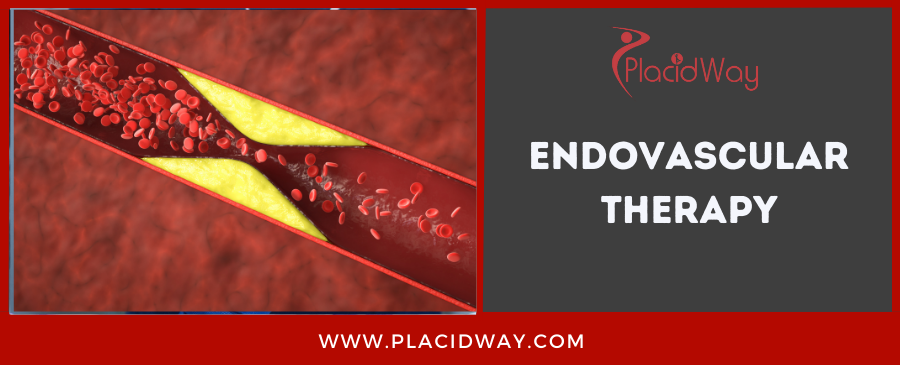
Considering Endovascular Therapy? Discover Hope and Healing Abroad
Navigating serious medical conditions can be overwhelming, especially when traditional surgical options seem daunting. If you've been diagnosed with a condition affecting your blood vessels, such as a brain aneurysm, a stroke, or peripheral artery disease, you might be exploring less invasive treatment paths. Endovascular therapy offers a beacon of hope, providing advanced solutions from within your arteries, often leading to faster recovery and less pain compared to open surgery.
This groundbreaking approach involves guiding tiny catheters and specialized instruments through your blood vessels, often from a small incision in your groin or arm, to reach the affected area. Imagine addressing a complex problem deep inside your body without the need for large incisions or extensive recovery periods. That's the promise of endovascular therapy.
Patients around the world are increasingly turning to this innovative treatment for various vascular conditions. From treating life-threatening brain aneurysms and acute ischemic strokes to clearing dangerous blockages in the heart and limbs, endovascular procedures are revolutionizing how we approach vascular health. If you're searching for "minimally invasive stroke treatment," "aneurysm repair without open surgery," or "blocked artery treatment options," you've come to the right place. We'll explore what endovascular therapy entails, who can benefit, and why seeking this advanced treatment abroad might be a smart choice for your health and your budget.
What symptoms might indicate a need for Endovascular Therapy?
Recognizing the signs that might point to a vascular problem is the first step toward timely treatment. Since endovascular therapy addresses a range of conditions, the symptoms you experience will depend on which part of your vascular system is affected. Here are some common indicators:
- Stroke Symptoms: Sudden numbness or weakness on one side of the body (face, arm, or leg), sudden confusion, trouble speaking or understanding speech, sudden trouble seeing in one or both eyes, sudden trouble walking, dizziness, loss of balance or coordination, and sudden severe headache with no known cause. These are often signs of an acute ischemic stroke that may require emergency endovascular thrombectomy.
- Aneurysm Symptoms: Often, unruptured aneurysms have no symptoms. However, a ruptured aneurysm can cause a sudden, excruciating headache (often described as "the worst headache of my life"), nausea, vomiting, stiff neck, blurred vision, sensitivity to light, seizures, or loss of consciousness. Peripheral aneurysms might cause pain, numbness, or tingling in a limb.
- Peripheral Artery Disease (PAD) Symptoms: Leg pain or cramping during exercise (claudication) that goes away with rest, numbness or weakness in the leg, coldness in the lower leg or foot, sores on the toes, feet, or legs that won't heal, a change in the color of your legs, hair loss or slower hair growth on the legs, and slowed toenail growth. This blockage can sometimes be addressed with endovascular angioplasty or stenting.
- Heart-related Symptoms: While endovascular therapy isn't typically for initial heart attacks, it can treat severe blockages that cause angina (chest pain or discomfort) or related issues requiring stent placement.
If you experience any of these symptoms, especially sudden and severe ones, it's crucial to seek medical attention immediately. Early diagnosis can significantly improve outcomes for conditions treatable with "endovascular intervention."
What are the main causes and risk factors for conditions treated by Endovascular Therapy?
Understanding the root causes and risk factors behind vascular diseases can help in prevention and early intervention. Many of the conditions treated by "endovascular specialists" share common culprits:
- Atherosclerosis: This is the most common cause of blockages (stenosis) and often contributes to aneurysms. It's a hardening and narrowing of the arteries due to the buildup of plaque, a sticky substance made of fat, cholesterol, calcium, and other substances. Risk factors include:
- High Blood Pressure (Hypertension): Damages artery walls, making them more susceptible to plaque buildup and weakening, which can lead to aneurysms.
- High Cholesterol: High levels of LDL ("bad") cholesterol contribute directly to plaque formation.
- Smoking: Nicotine and other chemicals in tobacco damage blood vessel walls, accelerate atherosclerosis, and increase the risk of blood clots and aneurysms significantly.
- Diabetes: High blood sugar levels can damage blood vessels throughout the body, making them more prone to narrowing and plaque formation.
- Obesity: Contributes to high blood pressure, high cholesterol, and diabetes.
- Lack of Physical Activity: Contributes to obesity and other risk factors.
- Age: The risk of developing vascular diseases generally increases with age as blood vessels naturally stiffen and weaken over time.
- Genetics/Family History: A family history of aneurysms, strokes, or heart disease can increase your personal risk.
- Inflammatory Conditions: Certain inflammatory diseases can affect blood vessels.
- Trauma: In some cases, severe injury can lead to vascular damage.
Managing these risk factors through lifestyle changes and medical intervention is crucial for preventing and controlling vascular diseases that might eventually require "minimally invasive artery repair."
What types of Endovascular Therapy procedures are available?
Endovascular therapy is a broad term covering several specialized procedures, each designed to address specific vascular problems from inside the blood vessels. Here are some common types:
- Angioplasty and Stenting:
- What it is: Used to widen narrowed or blocked arteries. A balloon-tipped catheter is inserted and inflated at the blockage site to compress plaque, and often a stent (a small mesh tube) is then placed to keep the artery open.
- Treats: Peripheral artery disease (PAD), coronary artery disease (CAD), renal artery stenosis, and carotid artery disease. Patients often search for "angioplasty without surgery" or "stent placement minimal invasion."
- Aneurysm Coiling (Endovascular Coiling):
- What it is: For brain aneurysms, tiny platinum coils are inserted into the aneurysm through a catheter, filling it and preventing blood from entering, thus reducing the risk of rupture.
- Treats: Cerebral (brain) aneurysms. Keywords include "brain aneurysm coiling procedure" and "endovascular aneurysm repair."
- Flow Diversion:
- What it is: A type of stent, called a flow diverter, is placed in the parent artery across the neck of a wide-necked or complex aneurysm. It redirects blood flow away from the aneurysm, encouraging it to thrombose and shrink.
- Treats: Complex brain aneurysms unsuitable for coiling.
- Endovascular Thrombectomy:
- What it is: An emergency procedure for acute ischemic stroke where a clot-retrieval device (like a stent retriever) is used to physically remove a blood clot from a large brain artery.
- Treats: Acute ischemic stroke caused by a large vessel occlusion. Patients search for "stroke clot removal" or "emergency endovascular stroke treatment."
- Embolization:
- What it is: Involves injecting particles (like glue, coils, or tiny beads) into a blood vessel to block it, often to stop bleeding or shrink a tumor.
- Treats: A variety of conditions, including uterine fibroids (uterine artery embolization), certain tumors, or arteriovenous malformations (AVMs).
- Transcatheter Aortic Valve Replacement (TAVR):
- What it is: A new aortic heart valve is inserted via a catheter, typically through an artery in the leg, without open-heart surgery.
- Treats: Aortic stenosis, especially in patients who are high-risk for traditional open-heart surgery.
Each of these "endovascular procedures" offers a tailored approach to complex vascular issues, emphasizing patient safety and recovery.
Who is an ideal candidate for Endovascular Therapy?
While endovascular therapy is a powerful tool, it's not suitable for everyone. A team of specialists, including vascular surgeons, interventional radiologists, and neurologists, will carefully evaluate your case to determine if you are an ideal candidate. Factors considered include:
- Specific Condition and Anatomy:
- Aneurysms: The size, shape, location, and neck of an aneurysm are critical. Some complex aneurysms might still require open surgery, while many are perfect for coiling or flow diversion.
- Blockages: The length, severity, and calcification of blockages influence whether angioplasty/stenting is feasible or if open bypass surgery is better.
- Stroke: For acute ischemic stroke, endovascular thrombectomy is primarily for large vessel occlusions, and the time from symptom onset is crucial (typically within 6-24 hours).
- Overall Health and Co-morbidities:
- Patients who may be high-risk for traditional open surgery due to age, heart conditions, lung disease, or other chronic illnesses are often excellent candidates for the less invasive endovascular approach.
- However, patients must be healthy enough to tolerate general anesthesia (though some procedures can be done with conscious sedation) and the recovery process.
- Kidney Function: The use of contrast dye during endovascular procedures requires healthy kidney function, as the dye is excreted by the kidneys.
- Allergies: Allergies to contrast dye, iodine, or specific metals in stents must be considered.
- Anticoagulation: Patients may need to stop certain blood thinners before the procedure and resume them afterward, which requires careful management.
Your medical team will conduct thorough diagnostic tests, including CT scans, MRI, and angiography, to precisely map your vascular system and assess the feasibility of "minimally invasive vascular surgery." Don't hesitate to ask, "Am I a candidate for endovascular treatment?"
What can I expect during recovery after Endovascular Therapy?
One of the primary advantages of endovascular therapy is its generally quicker and less painful recovery compared to traditional open surgery. However, "endovascular therapy recovery time" can vary based on the specific procedure, your overall health, and the complexity of the condition treated.
- Immediate Post-Procedure:
- You'll typically spend a few hours in a recovery room, where nurses will monitor your vital signs and the incision site (usually in the groin or arm).
- You'll need to lie flat for several hours to prevent bleeding at the access site.
- Pain at the incision site is usually mild and can be managed with over-the-counter pain relievers.
- Hospital Stay:
- For most endovascular procedures (e.g., angioplasty, coiling), the hospital stay is often 1-3 days.
- Emergency procedures like stroke thrombectomy might require a longer stay for neurological recovery and rehabilitation.
- Returning Home:
- You'll likely be advised to avoid heavy lifting, strenuous exercise, and prolonged standing for a week or two.
- Light activities, such as walking, are often encouraged soon after discharge.
- You may have some bruising or tenderness at the access site for a few days.
- Long-term Recovery and Follow-up:
- Full recovery and return to normal activities can range from a few weeks to a couple of months.
- Regular follow-up appointments with your doctor are crucial to monitor your progress, ensure the treated vessel remains open, and manage any underlying conditions. This may include imaging tests.
- Medications, such as antiplatelet drugs (e.g., aspirin, clopidogrel) or anticoagulants, may be prescribed long-term to prevent future clots.
Listen carefully to your medical team's instructions for post-procedure care to ensure the best possible outcome for your "endovascular treatment."
What are the potential risks and side effects of Endovascular Therapy?
While "endovascular surgery" offers significant advantages, it's still a medical procedure and carries potential risks and side effects. Your doctor will discuss these in detail, weighing them against the benefits of the procedure for your specific condition:
- At the Access Site (usually groin or wrist):
- Bleeding or Hematoma: Bruising and swelling at the site are common. More severe bleeding requiring intervention is rare.
- Infection: Any skin incision carries a small risk of infection.
- Nerve Damage: Very rare, but possible if a nerve is inadvertently irritated during access.
- Procedure-Related Risks:
- Allergic Reaction: To contrast dye (used to visualize blood vessels), anesthesia, or medications.
- Kidney Damage: The contrast dye can sometimes temporarily affect kidney function, especially in patients with pre-existing kidney issues.
- Blood Clot Formation: A clot could form on the catheter or at the treatment site, potentially leading to stroke or other ischemic events. Antiplatelet medications are often used to mitigate this risk.
- Vessel Damage: The catheter or instruments could inadvertently damage the blood vessel being treated or accessed, potentially leading to dissection or perforation.
- Radiation Exposure: Endovascular procedures use X-rays (fluoroscopy) to guide the instruments. The radiation dose is generally low but is a consideration.
- Specific Procedure Risks:
- For Aneurysms (Coiling/Flow Diversion): Re-bleeding, incomplete occlusion, or the need for repeat procedures.
- For Blockages (Angioplasty/Stenting): Re-narrowing of the artery (restenosis) over time, or stent fracture.
- For Stroke Thrombectomy: Further stroke, bleeding into the brain (hemorrhage), or reperfusion injury.
It's important to have an open conversation with your healthcare provider about "endovascular treatment risks" and how they apply to your personal health profile. They will take every precaution to minimize these risks.
How does the cost of Endovascular Therapy compare globally?
For many patients, the cost of advanced medical procedures like "Endovascular Therapy" is a major concern. Healthcare expenses, especially in countries like the United States, can be prohibitively high, leading many to explore "affordable endovascular treatment abroad." The good news is that significant savings can often be found without sacrificing quality, thanks to medical tourism.
Here's a generalized cost comparison for various endovascular procedures. Please note these are *estimates* and can vary widely based on the specific procedure (e.g., angioplasty vs. complex aneurysm coiling), hospital, surgeon's fees, duration of stay, and country:
| Procedure Type | USA (Estimate) | Europe (Germany/UK) (Estimate) | Medical Tourism Hubs (e.g., Turkey, India, Mexico, Thailand) (Estimate) |
|---|---|---|---|
| Angioplasty & Stenting (Peripheral) | $20,000 - $50,000+ | $15,000 - $35,000 | $6,000 - $18,000 |
| Brain Aneurysm Coiling | $60,000 - $150,000+ | $40,000 - $80,000 | $18,000 - $45,000 |
| Stroke Thrombectomy | $70,000 - $200,000+ | $45,000 - $90,000 | $20,000 - $55,000 |
| Flow Diversion (complex aneurysm) | $75,000 - $200,000+ | $50,000 - $100,000 | $25,000 - $60,000 |
These figures highlight why "endovascular therapy cost comparison" is a key driver for medical tourism. Countries like Turkey, India, Mexico, and Thailand offer state-of-the-art facilities and highly trained specialists at a fraction of the cost, making life-changing treatments more accessible.
Why should I consider Endovascular Therapy abroad?
The decision to travel for medical treatment is a significant one, but for procedures like endovascular therapy, the benefits can be compelling:
- Significant Cost Savings: As seen in the table above, the most compelling reason for many is the dramatic reduction in cost. These savings can make an otherwise unaffordable, life-saving procedure accessible. This is often the primary search intent behind "cheap endovascular treatment" or "affordable vascular surgery overseas."
- Access to World-Class Expertise and Technology: Many international hospitals specialize in medical tourism, investing heavily in the latest endovascular equipment and attracting highly skilled, often internationally trained, surgeons and interventionalists. You might find "best hospitals for endovascular therapy" are located outside your home country.
- Reduced Waiting Times: In many Western countries, long waiting lists for specialized procedures can delay critical treatment. Traveling abroad can provide immediate access to care, which is especially vital for time-sensitive conditions.
- High-Quality Care and Facilities: Leading medical tourism destinations boast internationally accredited hospitals (like JCI-accredited facilities) that adhere to stringent global standards for patient safety and quality.
- Privacy and Anonymity: For some, undergoing a major medical procedure away from their home country offers a greater sense of privacy.
- Personalized Attention: Hospitals catering to international patients often provide a higher staff-to-patient ratio, dedicated international patient departments, and concierge services, enhancing the overall patient experience.
Considering "endovascular treatment overseas" allows you to prioritize your health without the financial strain or delays often encountered in domestic healthcare systems.
Which countries offer the best value and quality for Endovascular Therapy?
When searching for "best country for endovascular treatment" or "top clinics for vascular surgery abroad," several countries consistently stand out for their blend of high-quality care, advanced technology, and affordability:
- Turkey: A rising star in medical tourism, Turkey boasts numerous JCI-accredited hospitals, particularly in Istanbul and Ankara. They offer state-of-the-art endovascular suites and highly experienced neuro-interventionalists and vascular surgeons, often at significantly lower costs than in Europe or the US.
- India: Known for its highly skilled doctors and world-class hospitals, India offers some of the most competitive prices for complex medical procedures, including various endovascular treatments. Major cities like Delhi, Mumbai, Chennai, and Bangalore have excellent facilities.
- Mexico: Popular for North American patients due to its proximity, Mexico offers high-quality care in cities like Monterrey, Tijuana, and Guadalajara. Hospitals are often accredited by international bodies and have English-speaking staff.
- Thailand: A long-established medical tourism hub, Thailand combines excellent medical care with a welcoming, service-oriented culture. Bangkok is home to several internationally renowned hospitals specializing in complex vascular procedures.
- South Korea: Known for its cutting-edge medical technology and highly specialized doctors, South Korea offers exceptional quality, particularly in complex neurological and cardiovascular interventions, often at more competitive prices than in Japan or Western countries.
- Germany: While at a higher price point than Asian or Latin American options, Germany is renowned for its stringent medical standards, advanced research, and highly specialized university hospitals, making it a top choice for those prioritizing premium European quality.
These countries have built reputations for providing "quality endovascular care overseas" and are excellent starting points for your research.
How to ensure safety and quality when seeking Endovascular Therapy abroad?
The thought of receiving medical treatment in a foreign country can understandably raise questions about safety and quality. However, with proper research and guidance, you can confidently choose a reputable provider for your "endovascular procedure abroad." Here's how:
- Choose Internationally Accredited Hospitals: Look for hospitals accredited by organizations like the Joint Commission International (JCI). JCI accreditation signifies that a hospital meets rigorous international standards for patient safety and quality of care. This is a strong indicator of "safe endovascular treatment overseas."
- Verify Surgeon Credentials and Experience: Research the treating physician's qualifications. Look for board certifications, specialized training in endovascular procedures, experience with your specific condition, and membership in international professional organizations. Ask about their success rates for the procedure you need.
- Review Patient Testimonials and Success Stories: Online reviews, forums, and patient testimonials can offer insights into other patients' experiences with the hospital and doctors.
- Transparent Pricing and Inclusions: Ensure you receive a comprehensive quote that clearly outlines all costs, including the procedure, hospital stay, consultations, medications, and follow-up care. Avoid hidden fees.
- Communication and Language Support: Confirm that there will be clear communication with your medical team, ideally with English-speaking staff or readily available translators.
- Post-Procedure Care Plan: Discuss the follow-up care plan, including how your recovery will be monitored and how ongoing medication or rehabilitation will be managed once you return home.
- Utilize a Reputable Medical Tourism Facilitator: Companies like PlacidWay specialize in connecting patients with trusted, high-quality international providers. They can help you with:
- Vetting hospitals and doctors.
- Obtaining medical records and initial consultations.
- Arranging travel and accommodation.
- Providing language support.
- Ensuring a smooth, worry-free experience.
By taking these steps, you can significantly mitigate risks and enhance the safety and quality of your "endovascular therapy abroad."
What are patient success stories from abroad for Endovascular Therapy?
The true measure of medical tourism's impact lies in the stories of patients whose lives have been positively transformed. While individual results vary, countless individuals have found renewed health and hope through "endovascular therapy abroad."
Consider the story of Maria, a 62-year-old from Canada, who faced a long wait for a complex brain aneurysm coiling procedure at home. Searching for "aneurysm treatment overseas," she discovered a highly-rated hospital in Turkey. Within weeks, she was able to travel, undergo a successful procedure, and return home with her aneurysm safely treated, at a fraction of the cost she would have faced domestically. She frequently shares her experience, highlighting the professionalism of the medical staff and the personalized care she received.
Then there's David, a 55-year-old from the UK, suffering from severe peripheral artery disease that caused debilitating leg pain. He was told he might need open bypass surgery. After exploring "PAD endovascular therapy abroad," he opted for angioplasty and stenting in India. His treatment was successful, and he regained mobility, able to enjoy long walks with his family again. David often speaks of the seamless process and the significant cost savings that allowed him to access the best care without financial strain.
These stories are not isolated incidents. They represent a growing trend of patients seeking and finding excellent "endovascular treatment results abroad." These individuals often praise:
- The attentive, often multilingual, medical teams.
- The modern facilities equipped with the latest technology.
- The efficiency and speed of getting an appointment and treatment.
- The holistic support provided, often including travel logistics and post-operative follow-up.
These "patient testimonials for endovascular therapy abroad" underscore the reality that high-quality, affordable care is not limited by geographical borders, offering a compelling alternative for those in need of advanced vascular interventions.
Take the Next Step with PlacidWay
Ready to explore treatment options abroad? Discover top clinics, compare prices, and get a free quote tailored to your needs with PlacidWay.
Vascular Surgery Abroad | Best Vascular Treatment Center



-Package-in-Kuala-Lumpur,-Malaysia-by-FirstCell.jpg)






Share this listing